
28/03/2024
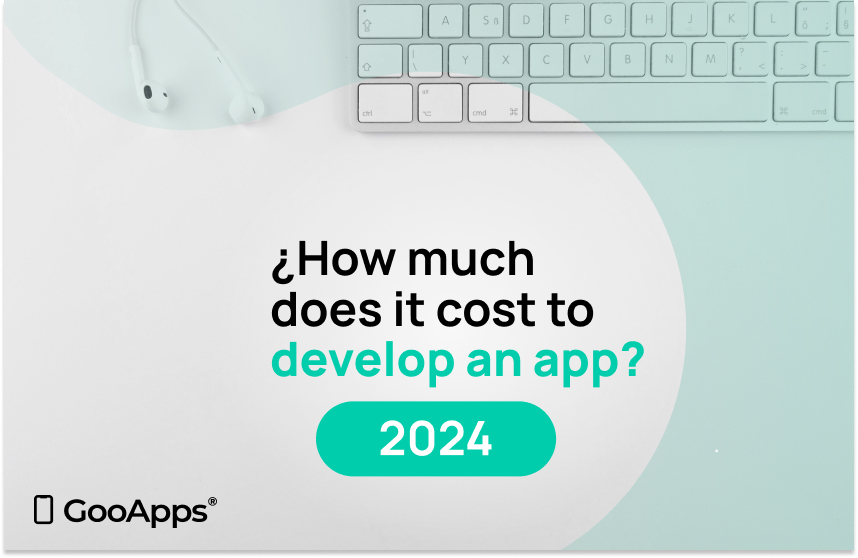
Over the years, the cost of developing a mobile app has undergone significant evolution. Factors such as the complexity of the design, the desired functionality, and the chosen platform have played a key role in determining this cost. However, in 2024, we find ourselves in a scenario where technology and user expectations have advanced by leaps and bounds, leading to a reevaluation of what it means to develop a mobile app and, consequently, how much it costs.
But, what factors have changed in app development in 2024 that could affect its cost? This year, the integration of emerging technologies such as artificial intelligence, machine learning, and augmented reality, along with increased attention to data security and accessibility, have introduced new variables into the mobile app development equation. Additionally, the growing need to create highly personalized and emotionally resonant user experiences has led to a sophistication in UI/UX design that previously was not considered standard.
These advancements pose an intriguing question: in a world where expectations and technology are constantly evolving, how much does it cost to develop an app in 2024? Throughout this article, we will go through the various factors that contribute to the cost of app development, exploring how each has been influenced by the trends and emerging technologies of the moment. Get ready to delve into a detailed analysis that will inform you about the current costs and provide you with a deep insight into how to optimize your investment in mobile app development in a year full of innovations.
As we delve into mobile app development in 2024, it’s important to understand that the cost associated with making an app is not a fixed value, but the result of a series of interconnected factors. Each application is unique, and its development involves a set of decisions that directly influence the final cost. From the initial conception to the launch and beyond, each step of the process carries specific cost considerations. In this section, we will explore the most influential factors that determine how much it costs to develop an app in 2024, providing a detailed guide for those seeking to understand this process.
The factors influencing the cost of app development can be grouped into several key categories, each of which we will address in detail:
Throughout the following sections, we will dig into each of these factors, showing how they influence the mobile app development process in 2024 and offering tips for effectively managing costs. This exploration will allow us to understand the variables that affect the price and how to optimize our decisions to develop high-quality apps in a cost-effective manner.
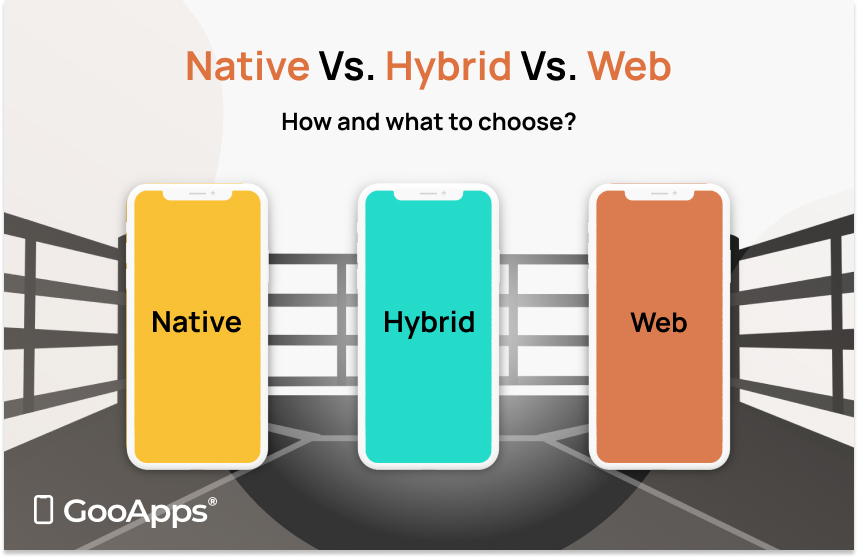
In mobile application development, one of the first and most important decisions to be made is the choice between native, web, or hybrid applications. This decision will affect the performance, user experience, and accessibility of the application, as well as the cost and complexity of development. Let’s see how each option impacts the budget and the development process.
Native applications are developed specifically for an operating system, such as Apple’s iOS or Google’s Android, using the development platforms and programming languages recommended by these operating systems’ manufacturers (Swift and Objective-C for iOS, Kotlin and Java for Android). These applications can take full advantage of the device’s hardware capabilities, offering an optimal user experience, fast response times, and deep integration with the device ecosystem.
Hybrid applications combine elements of native and web apps. They are built using web technologies (HTML, CSS, and JavaScript) and then packaged within a native container, allowing them to access device features and be distributed through app stores. Popular frameworks for hybrid development include React Native, Ionic, Flutter, and Xamarin.
Web applications are web pages optimized to be used on mobile devices through a browser. They are developed in web programming languages like HTML, CSS, and JavaScript. Unlike native applications, this type of app cannot be published in app stores (App Store and Play Store) and can only be accessed through a URL and a web browser. However, this feature allows the applications to be accessible from any device with an internet connection.
The choice between native, hybrid and web applications should be based on careful consideration of the goals of the project, target audience, desired features, and, of course, budget. Each type of application has its own advantages and disadvantages in terms of cost, performance, and the ability to offer a rich and functional user experience. By understanding how each option affects these aspects, businesses can make informed decisions that maximize the value of their investment in mobile app development.
In case there is not enough budget to hire the development of an application to a specialized company, there is the alternative of app builders, which offer a solution that tries to find a middle ground between cost and final product, although the app’s customization is limited.
The complexity of a mobile app is a determining factor in the cost of its development. This complexity is reflected both in the functionalities that the app offers and in its integration with third-party services and the use of specific device hardware. Understanding the relationship between an app’s complexity and its associated cost is essential for planning and budgeting development effectively.
Integrating with third-party services is another factor that can increase the complexity and cost of an app. Modern applications often require integrations with external systems for functions such as data analysis, payment management, maps, social networks, and marketing tools.
Each of these integrations needs to be configured and properly maintained, which can involve additional development and testing costs to ensure that the integration works smoothly and securely.
Leveraging the capabilities of the device’s hardware, such as GPS, camera, accelerometer, or biometric sensors, can also influence the cost of developing an application. The use of these features requires native access to the hardware, meaning that applications must be developed with special consideration for these integrations, increasing the complexity and the time needed for development and testing.
The implementation of advanced functionalities, integration with third-party services, and intensive use of the device’s hardware are aspects that can transform a simple application into a highly complex and sophisticated mobile solution. While basic functionalities may be suitable for applications intended to fulfill specific and simple functions, advanced functionalities are essential for applications looking to offer a rich, interactive, and personalized user experience.
In summary, the complexity of a mobile app is a component that directly affects the cost of its development. Careful planning and a clear definition of the project’s goals and requirements are essential to effectively manage the costs associated with the application’s complexity, thus ensuring that the final product meets user expectations and stays within the established budget.
Mobile application accessibility is a consideration that ensures all users, including those with disabilities, can use it effectively. This inclusive approach guarantees an app’s reach across the entire market, fulfilling required legal obligations while reinforcing a brand’s commitment to equal access to technology.
What does App Accessibility mean?
Accessibility in the context of mobile applications refers to the app’s ability to be used by people with a wide range of abilities and disabilities. This includes individuals with visual, hearing, motor, and cognitive disabilities. An accessible app takes into account these diverse needs by designing and developing interfaces and functionalities that can be easily used by everyone, ensuring that no one is excluded.
Legal Obligation for Accessible Design
Regarding the legal obligation of accessible design, there are notable differences between European and American regulations:
This legal framework highlights the importance of integrating accessibility into the development process from the start, not only to comply with these regulations but also to ensure that applications can be used by a broader audience, thereby expanding their reach and impact. Designing for accessibility promotes inclusivity and demonstrates a commitment to providing equal opportunities for all users, an essential aspect of ethical and socially responsible business practices.
Features of an Accessible Mobile App
An accessible mobile application incorporates several key features designed to facilitate its use by all users. Some of these features include:
Accessibility should be considered from the early stages of app design, ensuring that technology serves a broader purpose of inclusion and accessibility for all. The integration of these functionalities adds an extra layer in the development of the application, which also increases the final cost.
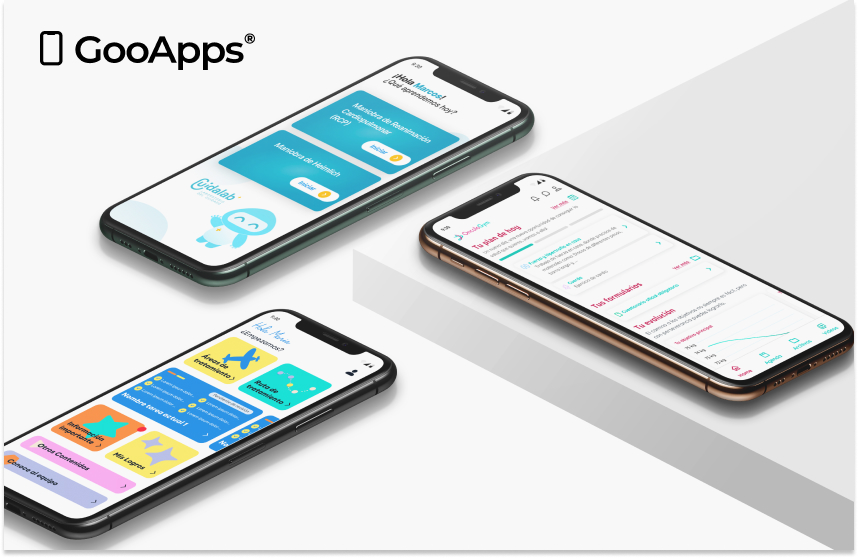
User Interface (UI) and User Experience (UX) design are critical components in the development of mobile applications, playing a key role in user retention. An intuitive and appealing design enhances user satisfaction, in addition to fostering greater interaction and loyalty towards the app. In this context, it’s important to understand how the level of design customization can impact the cost of app development.
A well-thought-out UI/UX design makes the application easy to use and visually attractive, which is essential for capturing and maintaining user attention. The user experience encompasses all aspects of the end-user’s interaction with the company, its services, and its products. Therefore, an effective UI/UX strategy must focus on the app’s aesthetics, as well as its functionality, usability, and accessibility.
Today’s users have high expectations and a low tolerance for poor user experiences. Complicated navigation, slow loading times, and poor arrangement of interface elements can quickly lead to user frustration and, ultimately, the app being uninstalled. On the other hand, an application that offers a smooth, consistent, and enriching experience is more likely to foster an active and committed user base.
The level of customization in an app’s design has a direct impact on development costs. Below are some key points:
In conclusion, while a custom and high-quality UI/UX design can increase the development cost of a mobile app, it also plays a fundamental role in creating a satisfying user experience that can translate into higher retention and user loyalty. The key is to find the right balance between the level of customization and the available budget, ensuring that the investment in design effectively contributes to the app’s long-term success.
Choosing the development platform for a mobile application is a strategic decision that has significant implications for both the cost and market reach of the app. In 2024, the two main platforms in the mobile app market are iOS and Android, each with its own set of guidelines, development tools, and user base. Additionally, the option of multi-platform development (third-generation hybrid app) offers an alternative that seeks to combine the best of both worlds. Let’s examine how these options affect development costs and market reach.
iOS
Developing an application for iOS generally involves using Swift or Objective-C as programming languages. The main development tool is Xcode. iOS apps tend to have a higher development cost due to the need to comply with the strict design and functionality guidelines set by Apple. However, Apple’s closed ecosystem can facilitate development and testing by limiting the variety of devices and operating system versions.
Android
On the other hand, developing for Android usually uses Kotlin or Java, with Android Studio as the primary integrated development environment (IDE). Developing for Android can be more challenging and expensive due to market fragmentation, with a wide variety of devices, screen sizes, and operating system versions. This diversity requires more extensive testing and adaptations to ensure compatibility and a consistent user experience across all devices.
Multi-platform
Multi-platform development tools, such as React Native, Ionic, Flutter, or Xamarin, allow developers to write a single code base that works on both iOS and Android. This approach can significantly reduce development and maintenance costs, as it eliminates the need to develop and manage two separate code bases. However, multi-platform applications may not offer the same level of optimization or access to operating system-specific features as native applications.
iOS
iOS applications have access to the market of Apple device users, characterized by having a higher purchasing power and being willing to spend more on applications. This can be especially relevant for paid applications or those with in-app purchases.
Android
With the largest global market share, developing for Android allows access to a broader and more diverse user base. This is particularly advantageous for applications looking to achieve maximum market penetration or targeting regions where Android dominates the smartphone market.
Multi-platform
Opting for multi-platform development maximizes market reach by making the application available to both iOS and Android users. Although there may be compromises in terms of performance and leveraging the specific features of each platform, this option is ideal for applications seeking rapid adoption and presence on all mobile devices.
The decision on which platform(s) to choose for app development should be based on an evaluation of the target audience, project goals, budget, and development timeline. While developing for a single platform may be suitable for applications with a well-defined target market, multi-platform development offers a more inclusive solution, ensuring that the app is accessible to as many users as possible.

Development personnel cost represent the main variable in the total cost of mobile app development. These costs vary considerably depending on the geographic region and the experience of the development team. Understanding how these factors influence the final cost is essential for effective planning and budgeting of any app development project.
The geographic location of the development team has a direct impact on the development hourly rate, reflecting differences in the cost of living, the demand for tech talent, and the general economic conditions of each region. Here is an overview of how these costs can vary:
eyond geography, the experience and specialization of the development team play a fundamental role in both the cost and the success and scalability of a mobile app project. An experienced team is capable of developing and launching high-quality applications more quickly, as well as bringing valuable strategic perspectives, identifying potential issues before they become too significant obstacles, and offering innovative solutions.
Investing in a highly experienced team, although it may increase the initial hourly cost, often results in long-term savings. This is due to a reduced need for costly corrections and a shorter development time, which ultimately increases the project’s chances of success. Beyond these savings, the team’s experience in specific industry regulations, especially in sensitive sectors like health and wellness, is invaluable. It ensures that the app complies with legal and safety standards from the start, in addition to offering an exceptional user experience.
Developer Team Experience and Product Quality
A development team with extensive experience equates to fewer errors in the final product and a better user experience. Skimping on development costs often results in low-quality products, plagued with errors, a poor user experience, and little to no scalability. Scalability, or an application’s ability to grow and adapt to increased demands without losing quality or performance, is essential to ensure the longevity and continued success of an app. Good technical architecture, designed by experienced developers, is key to achieving this goal.
At GooApps, many clients come to us after having relied on less experienced teams for the initial development of their apps, only to find that their products lack a solid foundation and scalable architecture, necessitating a complete rebuild from scratch. This scenario underscores the importance of making the right choice from the start, avoiding the false economy of opting for lower-cost but inferior quality solutions.
Accessibility: A Non-Optional Requirement
Accessibility is another critical aspect of mobile app development, one that many companies might be tempted to overlook to cut costs. However, beyond being an ethical imperative, implementing accessibility features is a legal requirement in the European market. An experienced team understands the importance of integrating these features from the start of development, ensuring that the app is accessible to all users, regardless of their abilities.
When considering development personnel expenses, it’s essential to balance initial costs with the long-term value that an experienced team can bring to the project. Choosing the right region and development team should be aligned with the project’s goals, available budget, and quality expectations. This ensures that the investment in mobile app development meets current standards for accessibility and regulations, as well as positioning the product for long-term success and scalability.
We must not forget to consider post-development costs of the App, such as:
Once an application is developed and launched, the next challenge is ensuring it reaches its target audience and achieves the highest possible number of active users. Effective dissemination and promotion of the application are essential for this purpose, encompassing strategies ranging from digital communication to effective publication in the App Stores. At GooApps, we understand the importance of these phases and offer a set of services designed to maximize the reach and visibility of our clients’ applications.
Strategic Communication and Promotion
At GooApps, we focus on a comprehensive communication and promotion strategy that includes the dissemination of success stories through our own channels, such as the GooApps website blog and our LinkedIn page. These platforms allow us to highlight the functionalities and benefits of the apps we develop, as well as share success stories and testimonials that can inspire potential users and clients.
In addition to using our internal media, promotion through external media plays a key role in the dissemination strategy. The selection of channels and tactics is customized for each project, ensuring that the message effectively reaches the target audience of the application.
Publishing on App Stores
At GooApps, we manage the app publishing process for our clients, ensuring that the application complies with all the technical and content guidelines of the iOS and Android platforms and is also optimized to stand out among the crowd. This includes creating compelling descriptions, selecting relevant keywords to improve visibility in searches, and using high-quality images and videos that showcase the app in action.
App Store Optimization (ASO) is an integral part of our publishing strategy, designed to increase the application’s visibility within the App Stores and improve conversion rates from views to downloads. This optimization is carried out through a careful analysis of market trends, user preferences, and competitor strategies.
Launch
The launch of an application, in addition to the possible costs associated with registering in the app stores (App Stores), can also involve other additional costs, such as those for acquiring security certificates and potentially, legal costs to ensure compliance with privacy and data protection regulations. At GooApps, we advise our clients on how to ensure compliance with these and other relevant regulations. Our advice ranges from the implementation of appropriate privacy policies to the adoption of data collection and storage practices that respect users’ rights. This guidance is essential to avoid legal penalties and ensure that the app maintains a positive reputation among users. These initial expenses are essential for a successful market entry.
Marketing
To ensure that the app reaches its target audience and generates downloads, it’s critical to invest in a well-planned and executed marketing strategy. This can include paid advertising, content marketing, public relations, App Store Optimization (ASO), and more. The costs associated with these marketing activities can vary widely, but allocating an adequate budget is essential for building visibility and traction in a highly competitive market.
As a point of reference, if the app is targeted at businesses (B2B), best practices suggest investing the same amount in marketing as was invested in the app’s development. If the app is aimed at end-users (B2C), it’s recommended to invest double in marketing what was invested in the creation of the app.
In this context, GooApps works in collaboration with EMMA, a partner specialized in user acquisition and retention for apps, offering a suite of integrated tools designed to maximize the impact of mobile applications. Incorporating EMMA into an app’s marketing strategy amplifies promotional activities and provides valuable insights for the continuous improvement of the product. Among the services offered are the following:
Maintaining a mobile app is an important aspect that ensures its optimal functioning over time, adapting to technological changes and user needs. At GooApps, we understand the importance of providing comprehensive maintenance that covers both corrective and preventive aspects, ensuring that the app remains relevant over time and offers the best possible experience to its users. Minimum maintenance starts at 10 hours per month and can increase depending on the number of users of the application. This maintenance can be classified into three main categories:
Preventive Maintenance
Corrective Maintenance
By investing in ongoing maintenance, GooApps helps ensure that apps not only continue to run smoothly but also evolve with their users’ needs, maintaining a competitive edge and high user satisfaction.
Adjustments
The implementation of these three types of maintenance ensures the operational continuity of the application, as well as its constant evolution in response to market demands and user expectations. At GooApps, our commitment is to provide continuous and adaptive support that ensures the applications we develop meet current standards and are prepared to satisfy future ones, maintaining their relevance and effectiveness over time.
To learn more about the maintenance costs of an app, you can consult our article on how much does it cost to maintain an app in 2024.
Mobile applications requiring a database, backend processing, or data storage need servers to operate. Costs can vary based on the provider (e.g., AWS, Google Cloud, Microsoft Azure), the scale of required resources, and the specific configuration (dedicated vs. shared servers, on-premise vs. cloud). It’s crucial to estimate expected traffic and storage needs to choose a hosting package that balances cost and performance.
Depending on the amount of information stored and traffic, storage costs typically range from €100 to €500 per month, in most cases.
We all hope our app will be a success, right? Then we will surely need new expansions, incorporate new functionalities, and general improvements of the application that we will implement in different versions. These updates are usually implemented through packs of 60, 120, or 250 hours.
After a detailed analysis of the factors influencing the cost of app development, let’s explore what this cost would be based on the complexity of the application and the functionalities included.
The price of an app can vary greatly, generally ranging from €25,000 to €60,000, or more. As is the case when making any other product, creating an app requires resources and different professional profiles. The main variables characterizing these resources, in the case of development, are time and the experience of the involved profiles. As Benjamin Franklin once said, “Time is money,” a phrase that perfectly applies in this case.
There are many factors that influence the price (time) of developing an app. As you can imagine, the more functionalities and complexity the app has, the higher the cost:
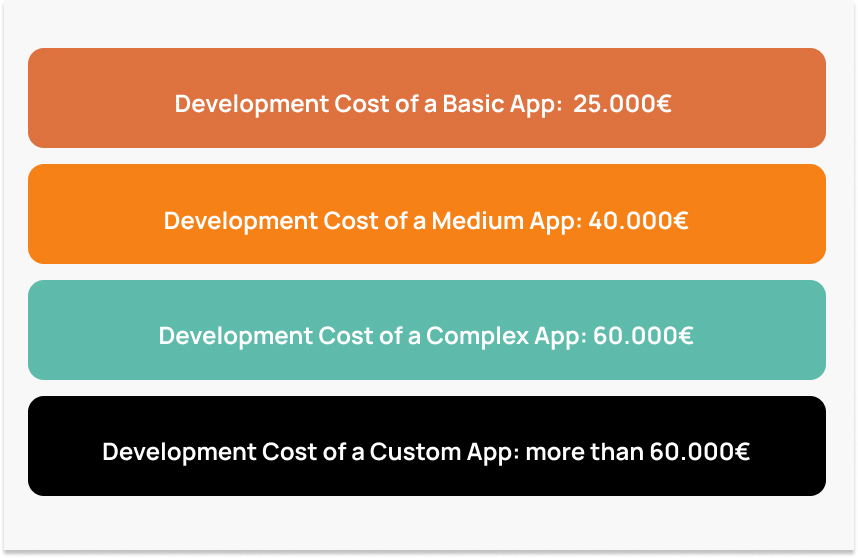
Do you want to know what we mean by a Basic App, a Medium App, a Complex App, and a Custom App? Do you want to know where the prices come from? Then keep reading.
As we have already mentioned, the main driver of the cost of developing an app is the time it takes to develop it. Let’s now talk about the correlation between time and the functionalities and complexity of developing a mobile app.
Functionalities and factors such as their technical architecture, integrations with other systems, APIs, or the volume of screens and buttons, in addition to the logic required for each of them, will determine the development time.
More complex developments may require highly customized programming, as well as the possibility of integrating IoT devices, wearables, or implementing advanced technologies such as artificial intelligence, virtual reality, or augmented reality.
Standard functionalities, on the other hand, are implemented much more easily.
As we have already mentioned, the cost of developing an app starts from €25,000 to more than €60,000, depending on its complexity, or the time it takes to develop it.
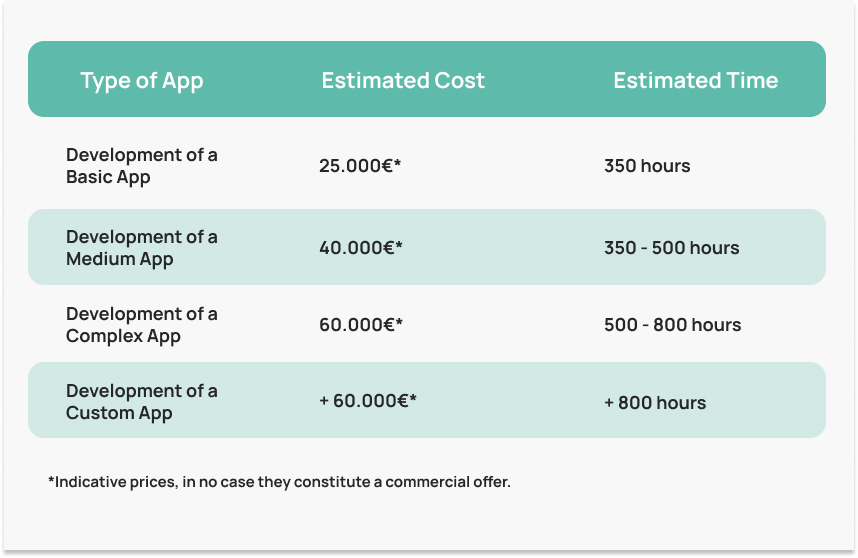
The answer to how much it costs to develop an app can vary greatly depending on the app’s functionalities. Browsing the internet, you’ll find many calculators that will give you very variable values in exchange for leaving your contact details. In reality, the most reliable way to calculate the cost is to contact a team of developers.
We talk about the level of complexity of developing an app. The smaller and simpler an app is, the less time its development takes. Seems obvious, right?
How many functionalities do you want to be implemented in the app? How many screens, buttons, functions do you want it to have? How complex is the app’s logic going to be?
The level of complexity in developing an app will depend on the functionalities and integrations you choose and how you are going to develop the app.
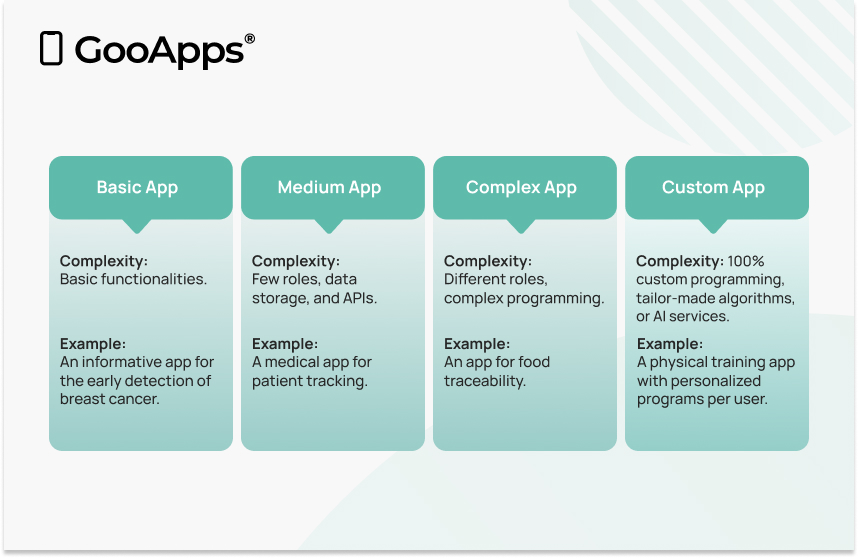
A basic app, that is, informational with static content that does not require connection to external platforms or content management, would take about 350 hours of work. It can have 2 basic functionalities, 3 or 4 screens, simple functions, and no storage.
An app of this type could have these main functionalities:
The usual development time for a basic app is typically around 45 days.

Why does an electric bicycle cost more than a regular one?
The same principle applies when we develop an app. The more functionalities and features we add, the more the development time increases, and therefore, the cost as well.
If we want to incorporate dynamic content, dynamize and manage it through its connection to a back office or content management system and customization, it would amount to a total of 350 to 500 hours of work.
This type of application could incorporate all the functionalities of a basic app, in addition to being able to add the following:
The more features you want to add to the application, the greater the development complexity, thereby increasing the final cost.
The usual development time for a medium app is typically around 60 days.
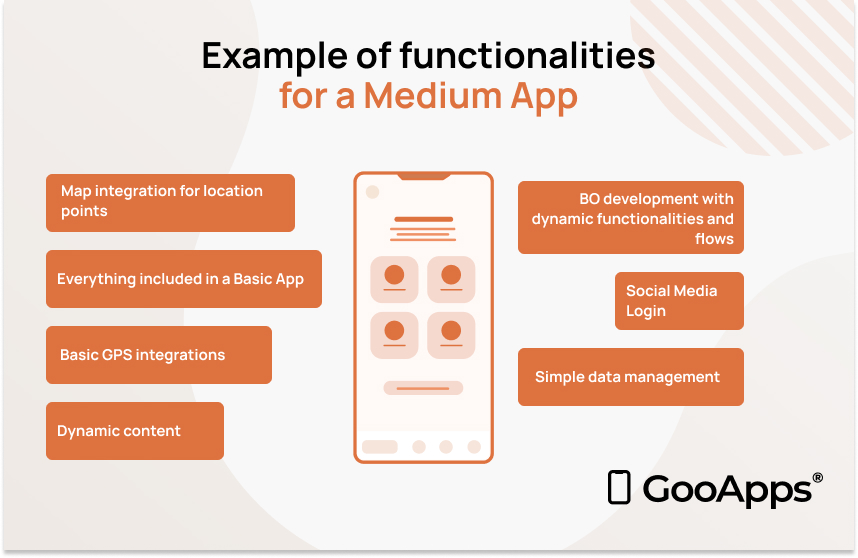
When the functionalities of a medium app are not enough, we can move on to complex cases, where we continue adding functionalities and features such as connection with IoT devices or wearables, support for offline work, as well as integration with external APIs. This type of apps can involve from 500 to 800 hours of work.
A Complex App could include the functionalities of a basic app and a medium app, in addition to:
The usual development time for a complex app is typically around 60 days.
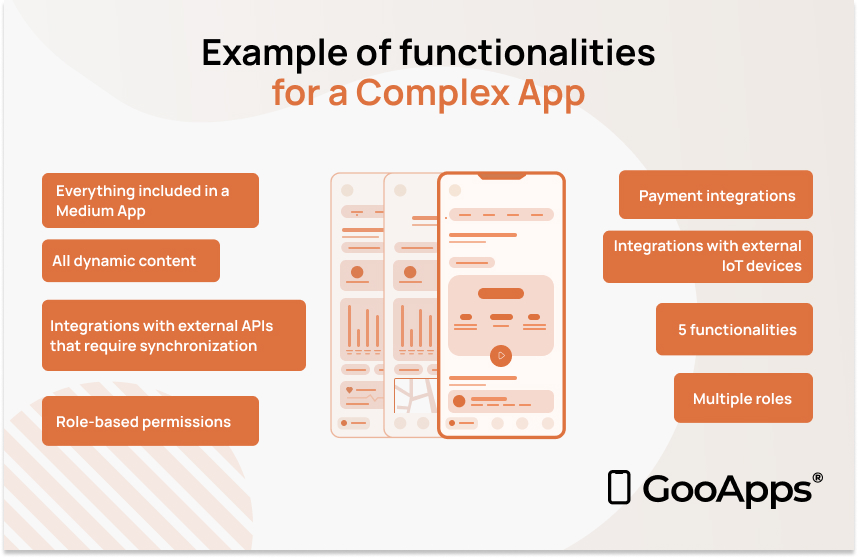
If you want to utilize the most cutting-edge technologies, such as integration with custom algorithms or AI services, as well as traceability functions through blockchain services, then a customized app is needed. This type of app requires a dedication of more than 800 hours of work.
A Customized App can include all the previous functionalities, in addition to:
The usual development time for a customized app is typically around 60 days.
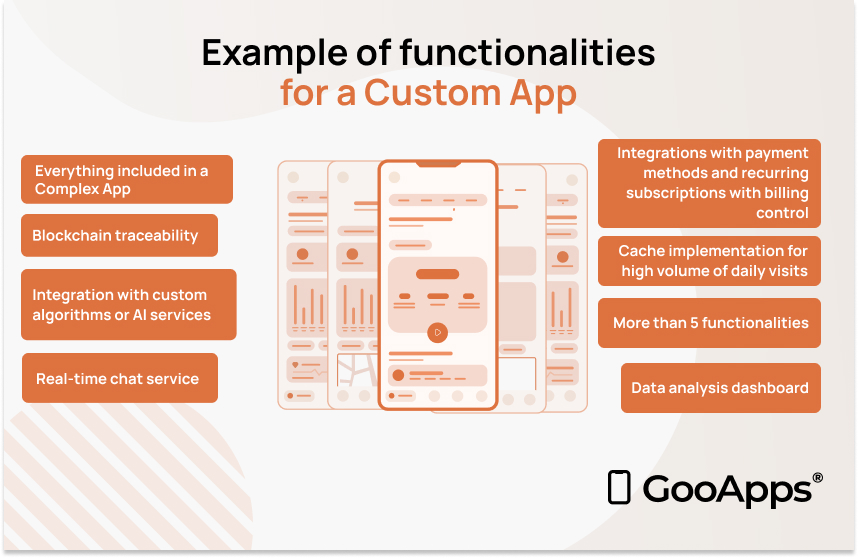
To conclude, can we say that in app development you get what you pay for? Absolutely! But finding a development price range that is realistic and fits your budget will be a critical aspect.
Remember, when we develop an app, at some point we expect to get a return on investment. To maximize the ROI, the developed App must be well-conceived, perfectly designed, and maintained professionally. And all this at a reasonable cost that you can afford.
In this article, we wanted to give you guidance on the cost of making a custom app. It’s true that prices vary a lot depending on each case, and it’s important that you understand the factors that influence design and development costs.
We recommend that you take all the time you need to analyze your real needs, the provider you will work with, and to define your goals and expectations clearly.
Once you have defined these points, do not hesitate to schedule a meeting to work with a mobile application development team that helps you design and execute your project.

Complete the form and GooApps® will help you find the best solution for your organization. We will contact you very soon!